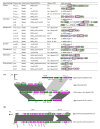Genomic Insights into Drug Resistance and Virulence Platforms, CRISPR-Cas Systems and Phylogeny of Commensal E. coli from Wildlife
- PMID: 34063152
- PMCID: PMC8148099
- DOI: 10.3390/microorganisms9050999
Genomic Insights into Drug Resistance and Virulence Platforms, CRISPR-Cas Systems and Phylogeny of Commensal E. coli from Wildlife
Abstract
Commensal bacteria act as important reservoirs of virulence and resistance genes. However, existing data are generally only focused on the analysis of human or human-related bacterial populations. There is a lack of genomic studies regarding commensal bacteria from hosts less exposed to antibiotics and other selective forces due to human activities, such as wildlife. In the present study, the genomes of thirty-eight E. coli strains from the gut of various wild animals were sequenced. The analysis of their accessory genome yielded a better understanding of the role of the mobilome on inter-bacterial dissemination of mosaic virulence and resistance plasmids. The study of the presence and composition of the CRISPR/Cas systems in E. coli from wild animals showed some viral and plasmid sequences among the spacers, as well as the relationship between CRISPR/Cas and E. coli phylogeny. Further, we constructed a single nucleotide polymorphisms-based core tree with E. coli strains from different sources (humans, livestock, food and extraintestinal environments). Bacteria from humans or highly human-influenced settings exhibit similar genetic patterns in CRISPR-Cas systems, plasmids or virulence/resistance genes-carrying modules. These observations, together with the absence of significant genetic changes in their core genome, suggest an ongoing flow of both mobile elements and E. coli lineages between human and natural ecosystems.
Keywords: CRISPR-Cas; E. coli; PLACNETw; WGS; antimicrobial resistance; wild animals.
Conflict of interest statement
The authors declare no conflict of interest.
Figures

 ). Boxes with the same color represent spacers that appear in ≥2 strains. There were no overlapping spacer sequences between CRISPR 1, 2, 3 and 4 arrays, thus colors must be independently interpreted for each array. The different symbols indicate spacers matching at least 88% with phages (∆), plasmids (●) or IS (~)-like sequences in databases. Origin: deer (D); bird of prey (BP); rodent (R); wild boar (WB). CRISPR/cas I-E (A, A *, B, C) and I-F1 structures (A, B) as well as cas genes clusters (E1, E2, F, F*) correspond to those represented in Supplementary Materials Figures S1 and S2, respectively. ND: non-determined.
). Boxes with the same color represent spacers that appear in ≥2 strains. There were no overlapping spacer sequences between CRISPR 1, 2, 3 and 4 arrays, thus colors must be independently interpreted for each array. The different symbols indicate spacers matching at least 88% with phages (∆), plasmids (●) or IS (~)-like sequences in databases. Origin: deer (D); bird of prey (BP); rodent (R); wild boar (WB). CRISPR/cas I-E (A, A *, B, C) and I-F1 structures (A, B) as well as cas genes clusters (E1, E2, F, F*) correspond to those represented in Supplementary Materials Figures S1 and S2, respectively. ND: non-determined.





Similar articles
-
Survey of clustered regularly interspaced short palindromic repeats and their associated Cas proteins (CRISPR/Cas) systems in multiple sequenced strains of Klebsiella pneumoniae.BMC Res Notes. 2015 Aug 4;8:332. doi: 10.1186/s13104-015-1285-7. BMC Res Notes. 2015. PMID: 26238567 Free PMC article.
-
Comparative pathogenomics of Clostridium tetani.PLoS One. 2017 Aug 11;12(8):e0182909. doi: 10.1371/journal.pone.0182909. eCollection 2017. PLoS One. 2017. PMID: 28800585 Free PMC article.
-
Mobilizable plasmids drive the spread of antimicrobial resistance genes and virulence genes in Klebsiella pneumoniae.Genome Med. 2023 Dec 1;15(1):106. doi: 10.1186/s13073-023-01260-w. Genome Med. 2023. PMID: 38041146 Free PMC article.
-
Pathogenomics of the virulence plasmids of Escherichia coli.Microbiol Mol Biol Rev. 2009 Dec;73(4):750-74. doi: 10.1128/MMBR.00015-09. Microbiol Mol Biol Rev. 2009. PMID: 19946140 Free PMC article. Review.
-
The CRISPR/Cas system as an antimicrobial resistance strategy in aquatic ecosystems.Funct Integr Genomics. 2024 May 28;24(3):110. doi: 10.1007/s10142-024-01362-7. Funct Integr Genomics. 2024. PMID: 38806846 Review.
Cited by
-
Correlation between CRISPR Loci Diversity in Three Enterobacterial Taxa.Int J Mol Sci. 2022 Oct 23;23(21):12766. doi: 10.3390/ijms232112766. Int J Mol Sci. 2022. PMID: 36361556 Free PMC article.
-
Comparative study of virulence potential, phylogenetic origin, CRISPR-Cas regions and drug resistance of Escherichia coli isolates from urine and other clinical materials.Front Microbiol. 2023 Nov 29;14:1289683. doi: 10.3389/fmicb.2023.1289683. eCollection 2023. Front Microbiol. 2023. PMID: 38094634 Free PMC article.
-
Molecular Characterization of Multidrug-Resistant Escherichia coli from Fecal Samples of Wild Animals.Vet Sci. 2024 Oct 1;11(10):469. doi: 10.3390/vetsci11100469. Vet Sci. 2024. PMID: 39453061 Free PMC article.
-
Identification and Characterisation of pST1023 A Mosaic, Multidrug-Resistant and Mobilisable IncR Plasmid.Microorganisms. 2022 Aug 8;10(8):1592. doi: 10.3390/microorganisms10081592. Microorganisms. 2022. PMID: 36014010 Free PMC article.
-
Escherichia coli CRISPR arrays from early life fecal samples preferentially target prophages.ISME J. 2024 Jan 8;18(1):wrae005. doi: 10.1093/ismejo/wrae005. ISME J. 2024. PMID: 38366192 Free PMC article.
References
-
- Touchon M., Hoede C., Tenaillon O., Barbe V., Baeriswyl S., Bidet P., Bingen E., Bonacorsi S., Bouchier C., Bouvet O., et al. Organised genome dynamics in the Escherichia coli species results in highly diverse adaptive paths. PLoS Genet. 2009;5:e1000344. doi: 10.1371/journal.pgen.1000344. - DOI - PMC - PubMed
-
- Johnson J.R., Kuskowski M.A., Gaiewski A., Sahm D.F., Karlowsky J.A. Virulence characteristics and phylogenetic background of multidrug-resistant and antimicrobial-susceptible clinical isolates of Escherichia coli from across the United States 2000–2001. J. Infect. Dis. 2004;190:1739–1744. doi: 10.1086/425018. - DOI - PubMed

